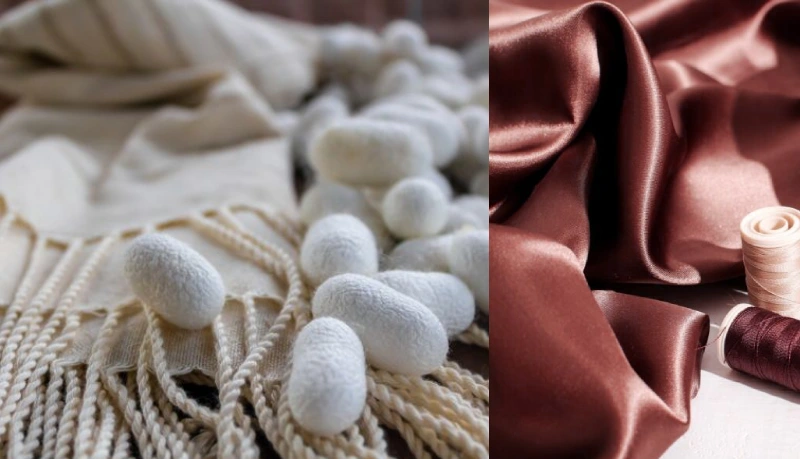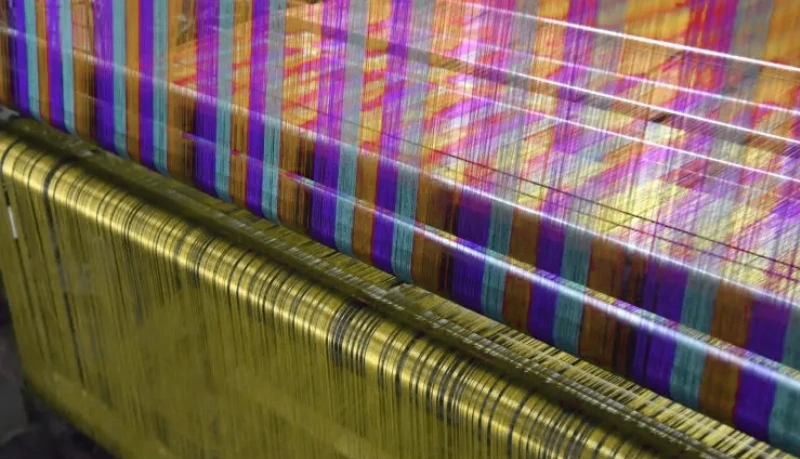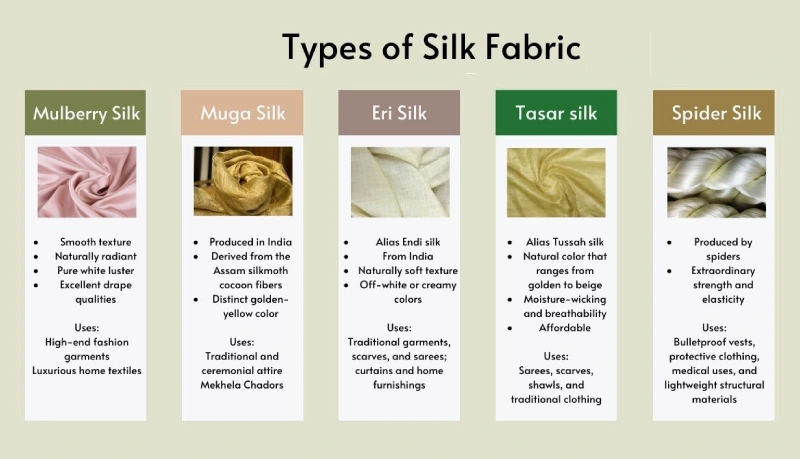Silk has long enchanted humanity with its delicate sheen, smooth texture, and luxurious feel. Originating thousands of years ago, this natural fiber continues to captivate both designers and wearers alike. Whether it’s in the folds of an elegant gown or the comforting embrace of fine pajamas, silk represents a perfect blend of nature and craftsmanship. But have you ever wondered how is silk made into fabric?

What Is Silk
Origins of Silk: From Ancient China to Modern Manufacturing
Silk dates back to around 2700 BCE, credited to ancient Chinese civilization. Legend tells of Empress Leizu discovering silk when a cocoon fell into her tea, unraveling into shimmering threads. Over time, sericulture—or silk farming—became a guarded secret, laying the foundation for the famed Silk Road. Today, while silk is produced globally, countries like China and India remain the largest producers.
Properties That Make Silk Unique
Silk’s uniqueness lies in its protein composition, primarily fibroin, which gives it a natural sheen and tensile strength. It’s lightweight yet strong, breathable yet insulating—qualities that make it highly sought after in fashion and home textiles. Its smooth, hypoallergenic surface makes it perfect for delicate skin.
How is Silk Made Into Fabric: Step-by-Step Process

Step 1: Sericulture – Cultivating Silkworms
The journey of silk starts with the domesticated silkworm, Bombyx mori. These caterpillars are raised in controlled environments and fed mulberry leaves. Over weeks, they spin cocoons from a single continuous fiber that can stretch over 1,000 meters long.
Step 2: Harvesting the Cocoons
Once the larvae encase themselves in cocoons, they are harvested carefully. Timing is crucial to prevent the moth from breaking the fiber. This step is vital to maintaining the long, unbroken filament prized in silk making.
Step 3: Boiling and Reeling the Silk Thread
The cocoons are boiled in water to soften the sericin—the gummy substance binding the thread. This process allows for the reeling of the silk filaments onto spools. Several filaments are twisted together to form a single thread suitable for weaving.
Step 4: Degumming the Silk
Degumming removes residual sericin to reveal the lustrous, soft silk fiber. This step is essential for achieving the smooth texture silk is known for and prepares it for dyeing or finishing.
Step 5: Spinning and Twisting the Threads
The reeled threads are spun and twisted to add strength and prepare them for weaving. Depending on the desired thickness and texture, the spinning process can vary significantly.
Step 6: Weaving the Silk Fabric
Using traditional handlooms or modern machines, the silk threads are woven into fabric. Weaving patterns and tightness can affect the feel, weight, and drape of the final textile.
Step 7: Dyeing, Printing, and Finishing
Silk takes dye exceptionally well, producing vibrant, rich colors. Finishing processes may include printing, calendaring (for shine), and treatment with softeners or anti-shrink agents to improve the fabric’s performance.
Types of Silk Fabric Produced

Mulberry Silk
The highest quality and most common silk, produced by Bombyx mori silkworms fed exclusively on mulberry leaves.
Tussar Silk
A wild silk with a coarser texture, mainly produced in India. It’s prized for its natural golden sheen and eco-friendliness.
Eri Silk
Soft, durable, and cruelty-free, as it allows the moth to emerge from the cocoon. It’s often used for shawls and scarves.
Muga Silk
Rare and unique to Assam, India. It has a natural yellowish-golden tint and is known for durability and sheen.
Sustainability in Silk Production
Environmental Impact
Traditional silk farming requires water, energy, and mulberry cultivation. However, sustainable practices like organic sericulture and zero-waste dyeing processes are emerging to reduce its footprint.
Ethical Sericulture Practices
Some producers now use “Ahimsa” or “peace silk,” where the moth is allowed to emerge naturally, aligning with cruelty-free and sustainable values.
Why Silk is Ideal for Pajamas
Unmatched Comfort and Breathability
Silk naturally adjusts to body temperature, offering coolness in summer and warmth in winter—perfect for uninterrupted sleep.
Hypoallergenic and Skin-Friendly
Its smooth fibers minimize friction, reduce irritation, and help retain skin moisture. Ideal for sensitive skin types or conditions like eczema.
Temperature-Regulating Qualities
Unlike synthetic fabrics, silk wicks moisture and allows air circulation, keeping you dry and comfortable through the night.
Spotlight on Silk Pajamas: Premium Loungewear at Its Best
Design Excellence and Tailoring Techniques
At our manufacturing facility, every pajama set is designed with both elegance and comfort in mind. From minimalist chic to classic silhouettes, we tailor each piece to offer a premium lounging experience.
How We Choose the Right Silk for Pajamas
We source only the finest 6A-grade mulberry silk to ensure durability, luster, and smoothness. Quality is non-negotiable, and our fabrics undergo strict testing for colorfastness, strength, and texture.
Our Commitment to Quality Craftsmanship
From stitching to seam finishes, every detail is handled by skilled artisans. We maintain low-volume, high-quality production to ensure that every piece meets our premium standards.
Silk Pajamas vs. Other Fabrics: A Comparative Analysis
Understanding why silk pajamas stand out requires a look at how they compare with other popular sleepwear fabrics.
Silk vs. Cotton Pajamas
Cotton is one of the most commonly used fabrics for pajamas due to its breathability and affordability. However, cotton lacks the smooth, luxurious texture of silk. Unlike silk, which helps retain skin moisture and offers a natural temperature-regulating effect, cotton can absorb moisture and may leave skin feeling dry. In terms of aesthetics, silk offers a graceful drape and elegant shine that cotton simply can’t match.
Pros of Silk over Cotton:
- Natural sheen and softness
- Better moisture retention
- Thermo-regulating for all seasons
Silk vs. Satin Pajamas
Satin is often mistaken for silk due to its glossy finish. However, satin is a weave pattern, not a fiber, and is usually made from polyester or nylon. While it’s cheaper, satin lacks the breathability and hypoallergenic benefits of real silk. Over time, satin may cause skin irritation or discomfort, especially for sensitive skin types.
Why Silk Wins:
- Breathable and skin-friendly
- Made from natural protein fibers
- Longer lifespan with proper care
Silk vs. Bamboo Fabric Pajamas
Bamboo pajamas are popular for their softness and sustainability. While bamboo fabric is breathable and eco-friendly, it doesn’t offer the same luxurious touch or classic appeal as silk. Bamboo is also less durable and may pill over time.
Silk Advantages:
- Timeless luxury and elegance
- Smoother against the skin
- More durable and resistant to wear
How to Care for Silk Fabrics and Pajamas

To maintain the quality and longevity of silk garments, proper care is essential. Though silk is delicate, following these simple steps will ensure it stays beautiful for years.
Washing and Drying Best Practices
- Hand wash in cold water using a gentle, pH-neutral detergent.
- If using a washing machine, select the delicate cycle and place items in a mesh bag.
- Avoid wringing; gently press out water with a towel.
- Hang or lay flat to dry away from direct sunlight.
Storage Tips to Extend Lifespan
- Store in a cool, dry place.
- Use padded hangers to maintain shape.
- Avoid exposure to perfumes and deodorants while wearing.
- Keep garments in breathable fabric bags to protect from dust and insects.
FAQs
Can silk be machine washed?
Yes, silk can be machine washed, but with extra care. Always use the delicate or silk cycle on your washing machine, and place the pajamas in a mesh laundry bag. Choose a mild, pH-neutral detergent specifically made for delicate fabrics. Use cold water and avoid spinning or high heat to prevent damage and shrinkage. Air drying is preferred to maintain the fabric’s softness and sheen.
Are there vegan or cruelty-free silk options?
Yes, there are vegan and cruelty-free silk alternatives available, such as Ahimsa silk, also known as “peace silk.” This type of silk allows the silkworm to complete its life cycle and emerge from the cocoon naturally, rather than being boiled alive. Additionally, synthetic silk alternatives like bamboo silk or Tencel can be considered by strict vegans, though they do not offer the exact same texture or benefits as real silk.
Do silk pajamas help with better sleep?
Silk pajamas significantly enhance sleep quality due to their natural softness, breathability, and ability to regulate temperature. The smooth surface reduces friction against the skin, minimizing irritation and sleep wrinkles. It also helps to maintain skin hydration, making it ideal for sensitive skin. These benefits contribute to deeper, more restful sleep throughout the night.
Do silk pajamas wrinkle easily?
Silk pajamas are less prone to deep wrinkling compared to cotton, thanks to their naturally elastic fibers. However, light wrinkles can still form, especially after washing or folding. These can be easily removed by hanging the garment in a steamy bathroom or using a steamer on a low setting. Proper storage and gentle handling also help maintain a smooth appearance.
Are silk pajamas worth the investment?
Yes, silk pajamas are worth the investment for those who value comfort, elegance, and skin benefits. They offer luxurious softness, excellent moisture regulation, and hypoallergenic properties. While they may cost more than synthetic alternatives, their longevity and the overall sleep experience they provide justify the price. With proper care, they can last for years, making them a smart and stylish choice.
Conclusion
The journey from silkworm cocoon to soft, breathable fabric is nothing short of magical. By understanding how silk is made into fabric, we gain a deeper appreciation for its rarity, quality, and luxurious feel. At our pajamas manufacturing facility, this appreciation translates into every stitch, seam, and silhouette. We don’t just make silk pajamas—we craft a sleeping experience that embodies elegance, comfort, and care.
Whether you’re looking to indulge in nightly luxury or offer your customers a premium product, silk pajamas stand unmatched. Choose silk. Choose serenity.


